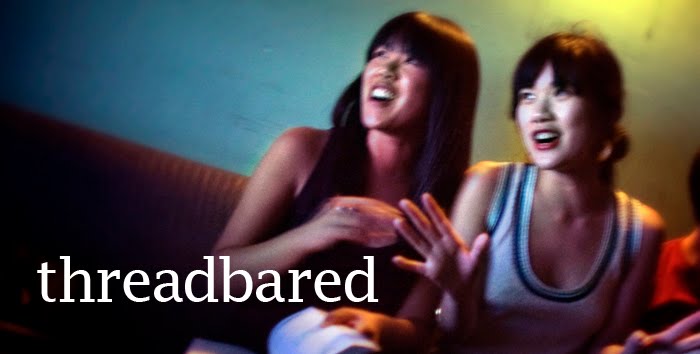
On one of the many episodes on Threadbanger, Corrine and Rob mentioned visiting the exhibition called Weavings of War: Fabrics of Memory. A collection of contemporary textiles by textile artists, mostly women, featuring images of war and strife, Weavings of War is (according to the synopsis) a project of bearing witness to death and dispossession, as well as survival and strength. (The site also includes a photo gallery. Here is another of the Afghan war rugs in particular, and a an article titled "Carpet Bombing" about the exhibit.)
This is a semi-roundabout way to mention two sites of particular interest for questions about textual and textile analysis in transnational circuits of consumption and capital. The first is (d)urban(a), the blog of Martha Webber, a doctoral candidate (who also happens to be certified in Power Sewing/Operating Industrial Garment Machinery and holds a degree in Fashion Design) writing about her ethnographic research in Durban, South Africa, with the non-governmental organization (NGO) Create Africa South, a organization that, among other activities (including HIV/AIDS education and prevention), encourages craft and textile production as both a creative exercise and an entreprenuerial practice. In her own words, her research "examines the contemporary craft literacy relationships formed between nongovernmental organizations and citizens of the 'global South' over questions of development and participatory democracy. My dissertation focuses on Black South African women from the Mpumalanga and KwaZulu-Natal provinces who engage in sewing and embroidery craft projects."
In a time and place far, far away, I wrote a position paper on handicrafts, NGOs, and globalization for my qualifying exams, so I'm thrilled to be able to catch up on some of the latest scholarship. Martha writes about the Weavings of War exhibition catalog here in order to explain her intellectual and political interests in textile arts:
In November of 2006 while writing a review essay on "material rhetoric," I included a catalog from the exhibition "Weavings of War: Fabrics of Memory" in my consideration of "material" engagements with the public sphere. In that essay I argued that a rhetoric of material insists textiles and clothing possess materialized agency, like Alfred Gell's notion of a secondary agent in Art and Agency or the notion of an actant in actor-network-theory. In positing a rhetoric of material, we can challenge the Western depth ontology that devalues surface and expand the possibility of what may count as rhetorical engagement, as well as the types of cultures and actors who can produce rhetoric.
Her blog is a fascinating (and funny) account working with one of the many handicraft NGOs in the "global South," which stock the shelves of such stores as 10,000 Villages in the "global North," full of tales of technologies gone awry, bureaucratic wrangling with donors, and details from the workshops on creating and producing the Amazwi Abesifazane cloth. Another excerpt from the latter:
Hand embroidery is a time-intensive medium. It allows the producer time to make decisions and to add and subtract items relatively easily (provided the selection of fabric, needle, and thread are compatible and you're not using a large needle with a delicate fabric, for example, and rending holes in the fabric if you decide to remove any stitching). What has continued to interest me about the embroidery for these particular cloths, is that the images that are slowly and carefully embroidered are meant to represent past histories and living conditions of the producers sewing them. What thoughts does the producer consider, in this case Thandi, when she is embroidering a small, irregular rectangle that is meant to stand in and represent someone she has known that died? How does it feel to embroider personal and representative subject matter, especially if you know it is intended for a larger audience?
Martha has also found some amazing archival materials supporting a connection between colonial authorities and missionaries encouraging "native" craft industries as civilizing projects. Martha's done some great work at the blog, and I cannot wait to read her dissertation, including footnotes!
The second piece I want to note here is Minoo Moallem's collaborative multimedia essay at the e-journal Vectors, called "Nation on the Move." It's a breathtakingly nuanced work that I can't begin to describe (which is really enhanced by the digital technologies used to illustrate and interact with her words), so here is an excerpt from her author statement:
In this essay, I focus on the Persian carpet as a borderline object between art, craft, and commodity. I interrogate the politics of demand and desire that derive from the modern notions and imaginaries of home and homeland as well as consumer pleasures arising from the conveniences and commodiousness of a repetitious consumer activity. The Nation-on the-Move involves a multidimensional, multilocational, and polyvocal approach by way of digital technologies. It recognizes the unevenness of time (time of production, advertisement, online auctions, and consumption); the mingling of the old, the new, and the emergent; spatial proximity or distance (here, there, and elsewhere); and the relation of nonvalue to use value and exchange value in a "scopic economy" that subsidizes the flow of representations for the history of material objects by producing audiences/spectators with a scattered and disconnected sense of attention. To challenge the shattering effects of consumerism, the designer and programmer, Erik Loyer has created what could be similar to a panel-design carpet that brings into the same frame of reference different times, spaces, and locations—real, fictional, and virtual—including ethnographic photography, TV auctions, movies, Orientalist painting, advertisement, museums, and art galleries.



